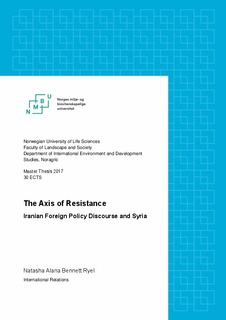| dc.description.abstract | In this analysis, I ask the question: How is the Syrian conflict represented and framed in official Iranian foreign policy discourse between 2011 and 2016, and how is Iranian involvement justified internationally? Intrigued by how the Iranian international relations, and how the regime has manages to develop an official foreign policy that is able to adapt to regional developments and challenges, this thesis sets out to explore how the Iranian official foreign policy discourse has framed the ongoing conflict in Syria.
Central to understanding Iranian politics, is the understanding of how Iran frames its foreign policy goals, and how they are projected and justified internationally. The particular foreign policy discourse that developed around the Iranian understanding of the Syrian conflict must also be understood within the regional context, and how Iran has responded to these regional developments. This thesis has therefore decided to examine the development of Iranian official foreign policy in Syria in relation to two other significant regional developments. By placing the Syrian discourse within a larger foreign policy context, this thesis will attempt to identify patterns and changes, and how these might be related to the Iranian perception of national identity.
By applying poststructuralist discourse analysis, this thesis investigates the relationship between official foreign policy discourse and identity. The findings from the analysis shows that the Iranian regime initially responded to the Syrian conflict with silence, as it did not fit into the Iranian ‘Islamic Awakening’ discourse. After some time, the Syrian conflict was eventually co-opted into the already established Iranian anti-imperialist discourse. This discourse developed to accommodate for developments in the conflict. One of these changes was to expand the enemy perception to include takfiri terrorists. This discourse maintained its stability throughout the rest of the period, despite President Rouhani’s attempt to establish foreign policy with a more diplomatic approach.
This thesis finds that Iranian foreign policy discourse has a great ability to adapt to new events, because of its relationship with the perception and projection of national identity. The foreign policy’s stability and adaptability is due to the revolutionary resistance identity, combined with a perception of Iranian exceptionalism. | nb_NO |

